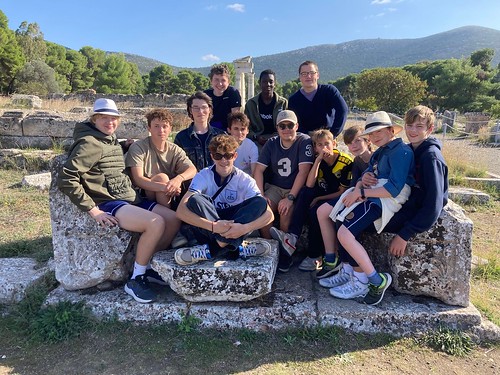
Lured by the promise of being able to speak ancient Greek in three days and write Linear B in five, a small band of Sherborne Grecophiles, an enthusiastic and excitable cacophony of intellectual anarchy, set out on an epic adventure.
A 30-minute walk from our hotel, what better place to start our two-day stay in Athens than the stunning Acropolis Museum. Processing over the glass floor, beneath which lie the ruins of an ancient Athenian neighbourhood, up the entrance steps that emulate the climb up to the acropolis, alongside ceiling-high displays of some of the finest Athenian pottery, and past carvings of heads, shins, ears and feet, votive dedications to Asclepius, the god of healing, we wound our way amongst the myriad of statues, of calf-bearers, korai and kouroi, all bathed in natural light, before we reached the museum’s crowning glory, the top-floor Parthenon Gallery, a glass atrium housing the temple's 160m-long frieze, mounted as it once was on the outside of the internal building. Here, strolling along as though atop the columns themselves, looking out towards the majestic greatness of the Acropolis, our YouTube wannabes first stood in awe of the Greeks.

For a tour of the Acropolis itself, we were entrusted to the enthusiastic and thorough Nikos, who showed us around a windswept Acropolis, imparting all he could in the limited time available and answering everything our keen students asked, including information on the fascinating choragic monument of Thrasyllos, before leaving us in a restaurant in the back streets of the Plaka, gorging ourselves on lamb chops. This was followed by a visit to the evocative Athenian agora and the Pnyx, the birthplace of democracy, where our boys were captivated by Socrates’ prison and the ostraka, the shards of pottery with names inscribed on them that were used to exile unpopular politicians, before a visit to the National Archaeological Museum, one of the largest and richest museums in Greece. ‘I have looked on the face of Agamemnon.’ No, not the cry of 19th century archaeologist Heinrich Schliemann, but that of the Fifth Form looking on the gold funeral mask of Agamemnon, one of the many prescribed sources that before now they had seen only in their textbooks.
Day four and we were driving into the mountains, past ski resorts towards ancient Delphi, hidden in the folds of Mount Parnassus. Standing at the very top of the Pythian stadium, looking down over the theatre and temple towards the sea below, it is not difficult to wonder why the god Apollo chose to site his oracle in this most stunning of landscapes or to understand why Zeus himself, as well as the Greeks, believed that this was the very centre of the mythical and spiritual world. Scattered around the site are the remains of many statues, offerings and temple-like treasuries that mark the importance of Delphi in the ancient world. Inscribed on the walls of the temple of Apollo are said to have been hundreds of ‘maxims’ (a moral rule or principle), such as the famous ‘Know thyself’ and ‘Nothing in excess’, but also the less well-known, but equally appealing ‘Never tire of learning’ and ‘Complete the race and don’t chicken out’, all of which were supposedly attributed to Apollo and designed to be copied down by students to improve their moral core.
Day five involved walking in the footsteps of the greats. First, we visited Mycenae, palace of Agamemnon, looking up at the ‘Cyclopean’ walls and passing beneath the great Lion Gate, before standing on the highest point of the palace and listening to stories of how Agamemnon was not buried in one of the massive tholos tombs below, but had been absorbed into the very rocks of the Greek landscape that surrounded us. Tiryns was no less splendorous, as we imagined how the great heroes of the Mycenaean world had lived, hunting out his megaron, his baths (and his fish tanks?). Our day ended as we sat in the theatron of the theatre of Epidaurus, awestruck again by the breath-taking beauty of the site and by the technological ingenuity of the Greeks, before being routed by a screaming horde of even more enthusiastic children.
Looking down from the plane on the sprawling metropolis that is Athens as we flew back home, I pondered once again the value of such trips, this one shorter, but no less successful than the many Classics trips I have led in the past. For many, a trip such as this brings to life the ancient world, forms an important backdrop to the culture of a civilisation very different from our own and offers a greater depth of understanding of their GCSE and A level courses. They are also great fun!
Stephen Heath, Head of Classics








%20(1).jpg?command_1=resize&height_1=85)
.jpg?command_1=resize&height_1=85)















